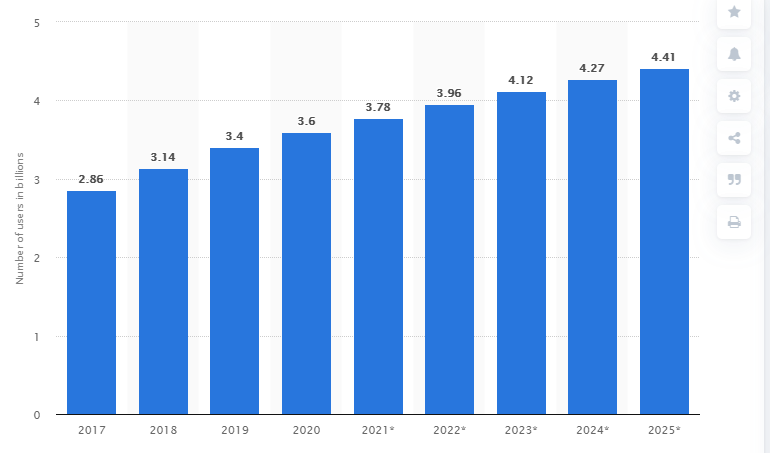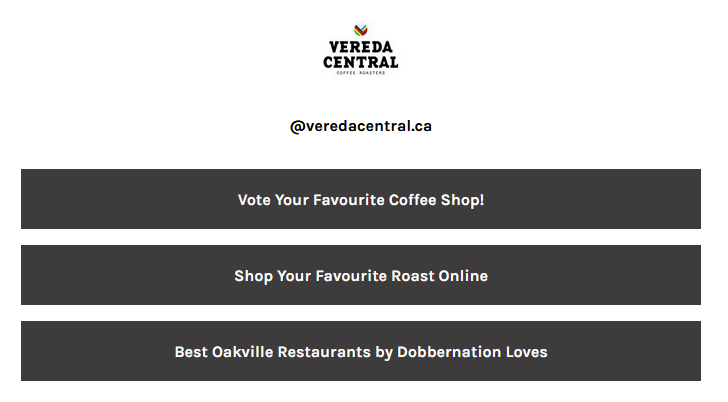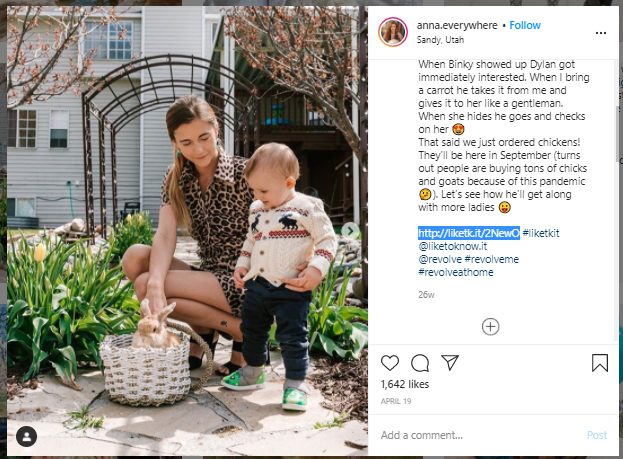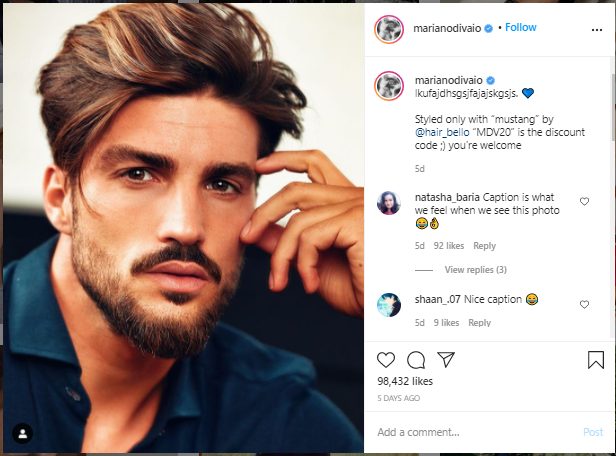Affiliate marketing, if done right, is lucrative for both the merchant (the business running the program) and for the affiliate. According to digital marketing expert Neil Patel, a strong affiliate can earn anything from $10,000 to $400,000 a year. Super affiliates can earn significantly more.
Naturally, I don’t want to make any promises about income potential, as there are many factors at play in determining how much you earn. However, the numbers speak for themselves: affiliate marketing can be lucrative.
Affiliate marketing is not just for bloggers, either. There’s also a space with huge potential for social media influencers. Good influencers have a large and highly engaged audience that trusts them to provide recommendations. That means there’s tremendous potential for influencers to also be highly successful affiliate marketers.
In this article, we’ll focus on affiliate marketing on Instagram, one of the world’s biggest social media platforms.
Let’s dive in!
Why Do Affiliate Marketing on Social Media?
Social media is something businesses cannot afford to ignore. According to Statista, an estimated 3.6 billion people are using social media worldwide as of 2020. That number is expected to increase to an astounding 4.41 billion by 2025:

In other words, the audience you’re trying to reach is almost certainly on social media. That means that social platforms represent an amazing opportunity for both merchants and affiliates.
Before I end this section, I want to dispel a myth about the reputation of affiliate marketing. Although it is true there are a minority of unscrupulous marketers who engage in unethical practices, it’s unfair to generalize all affiliates in this way.
At its best, affiliate marketing allows influencers, bloggers, and enthusiasts to benefit from promoting the products that they use and love.
The vast majority of both merchants and affiliates engage in reputable marketing practices and value their audience’s trust over making a quick sale.
What You Need to Know About Affiliate Marketing On Instagram
So out of all the social media platforms available, why choose Instagram? There are currently over one billion monthly Instagram users. It is one of the most popular social media platforms in the world, beaten only by Facebook and Youtube.
Over two thirds of the total number of Instagram users are aged 34 and below. This makes it particularly attractive for marketers targeting that demographic – which is well worth doing, since the 18 to 34 group wields $1.3 trillion in annual buying power.
With Instagram, companies can boost awareness of and engagement with their brand, while increasing website traffic. By working with affiliates and influencers, their reach can be dramatically increased.
Choosing the right affiliate program
If you’re new to affiliate marketing, you might be wondering which affiliate programs to join. Don’t panic – the options can seem endless, but I’ve put together this easy cheat-sheet to help you choose the best one for you.
- Read up on the best affiliate marketing programs in your niche and ask others for their input.
- Select companies with products that you already use and love.
- Look for generous commission rates and high average earnings per click (EPC).
- Choose programs with a minimum cookie lifespan of 30 days. Longer is preferable.
- Choose a program with robust technical capabilities including postback tracking, dynamic product feed, and the ability to create deep links to any page on the merchant’s site.
I recommend that you don’t spread your efforts too thinly. Focus on just one or two programs to begin with. You can always scale and add more later!
Solving the “one link” problem
Instagram can seem problematic for marketers because you cannot include a clickable link in an image caption. You can also only add one clickable link to the Instagram bio.
Fortunately, linking tools like lnk.bio and Linktree allow an easy way around this. Adding one of these tools to your page allows you to create a simple URL that leads to a landing page hosting all your links. Here’s an example of how a simple Linktree page can look:

As an affiliate, you can use a linking tool for all your affiliate links. Once you have over 10,000 followers, you can also use the “swipe up” function to add a link directly to your Instagram Stories.
Taking your affiliate marketing to the next level
So you’ve joined an affiliate marketing program, your audience is growing, and the commissions are rolling in. Congratulations! What next? It’s time to take your marketing up a notch and boost your sales even more.
If you’re using an affiliate tracking solution like Anytrack, you can make use of it alongside a marketing system like Wishpond. This means you can learn more about your audience and segment them accordingly. By capturing contact, demographic, and behavioral data about your site visitors and customers, you can learn a huge amount about them and their preferences.
For example, you might wish to market different products to women than men. You would likely use different language when addressing young people and college students than you would when addressing an older audience. Especially when discussing topics like student banking.
If you’re capturing contact information such as email addresses (and you should be!) you can use this data to enhance your email marketing campaigns. Why not trigger marketing emails based on certain actions?
For example, if someone clicks through on one of your affiliate links but doesn’t buy, can you send an “abandoned cart” style email to encourage them to complete their purchase? If someone buys a certain product through one of your affiliate links, you can use that information to market relevant products to them in the future.
For example, let’s imagine you’re in the tech niche and someone purchases a laptop. You could use that data to market products like mice, keyboards, docking stations, and laptop cases.
You might also wish to start investing in paid posts on Instagram. This can get your content in front of a much broader audience. Even a relatively small financial investment can dramatically boost your engagement and, ideally, your commissions. There are three ways to use paid posts on Instagram:
- Promote an Instagram post through the Instagram app (you’ll need a business account for this)
- Connect your Instagram account with Facebook and create an ad through the Facebook Ads Manager system
- Create an Instagram Stories ad using the Facebook Ads Manager.
Whichever option you choose, the trick is in how you set your audience parameters. Instagram’s platform allows you to define your audience based on demographics, location, and areas of interest, so you can finely tune who you’re targeting. If you wish, you can even run more than one campaign and use it to target different segments of your audience.
You can use the data gathered through your affiliate tracking system to determine what will resonate with which audience and what kinds of links they’re most likely to click on.
5 Awesome Examples of Affiliate Marketing On Instagram
Now that you understand how affiliate marketing on Instagram works and how to get started, let’s look at some great examples. I’ve picked out a few affiliates who I think are doing particularly well to inspire you.
Affiliate Marketing on Instagram Example #1: Erica Ligenza and Colleen Rothschild Beauty

This post is a great example of affiliate marketing on Instagram for so many reasons. First, there’s the personal touch in the caption when Erica Ligenza, an influencer in the fashion and beauty niche, refers to her 90,000+ followers as her friends. This automatically establishes a connection and increases the chances that her followers will trust her recommendations.
People prefer to buy from those they like and trust, after all, so take the time to build a real connection. Erica also tagged the company so that, when her followers become interested in the product, they can also check out the company’s Instagram page.
The sense of urgency in the caption was another great touch. By telling her followers that “today” is the last day of the salt, Erica pushes them to act fast. This is a classic example of FOMO, or fear of missing out, in action. Remember that your customers are more likely to take action if you make it clear they have a limited time to do so.
Lastly, the 3-step facial at home guide was a good finishing touch. With the step-by-step guide, Erica shows her followers exactly how to use the products. This allows them to imagine themselves using the items, increasing desire to buy them.
Affiliate Marketing on Instagram Example #2: Anna Everywhere

A secret to amazing Instagram affiliate marketing? The Instagram posts don’t need to be directly about the products being promoted.
This one, by travel influencer Anna Karsten (@anna.everywhere), shows Anna and her son wearing the clothes she is promoting. But the caption doesn’t even mention the clothes. Instead, Anna talks about her son Dylan and how he interacts with their pets.
Only by clicking the link will you find that she’s promoting children’s clothing items from Ralph Lauren, Saks, Maisonette, and Amazon. That’s a lot of affiliate mileage out of one post!
The reason this works so well is because the picture is eye catching and the content is engaging. By including a picture of her young son and a rabbit, Anna relies on the always-effective “awww” factor for this post. Additionally, the content tells a story and provides some advice for parents unsure about how their children will interact with animals.
Instagrammers who decide to go this route should make sure their captions are interesting enough to keep followers reading until the end, where their affiliate link is. Telling a story, sharing some advice, or giving your opinion on a subject are all great ways to provide engaging content.
The picture also has to be eye-catching and relevant. If you fail in either of these two tasks, followers won’t even get as far as clicking the link.
Affiliate Marketing on Instagram Example #3: Imjennim

This Instagram post, by fashion influencer Jenn Im, stands out thanks to its creativity. Instead of just taking a picture of the Creme Shop lipstick she is endorsing, Jenn went a step further and did a full photoshoot with herself as the model. The color scheme is aligned with the product she’s promoting, and the result is a glamorous vibe of the kind that would look at home in a glossy magazine.
What can you learn from this post? The concept behind an image should be compatible with the product that is being endorsed. Take the time to think about use of color, setting, and the way the picture is edited.
The caption is straightforward – it talks about the product and its stand-out features. It’s short, but it does what it needs to do. Additionally, the use of a relevant emoji adds a playful tone, which will appeal to Jenn’s young audience.
Notably, she uses her Instagram account to promote her Youtube channel, which is linked in her bio and where she also promotes her affiliate links. If you’re active on Youtube and promote affiliate products there, this is another way to drive traffic and increase your commissions.
Affiliate Marketing on Instagram Example #4: Mariano Di Vaio and Hair Bello

Long captions aren’t always necessary to get the attention of your audience. This one, from fashion influencer Mario Di Vaio, is really short. Not only that, but the first part isn’t even a real word!
The nonsensical opening to the caption denotes playfulness and identifies Mario as a fun, happy-go-lucky type of person. It also suggests incoherent excitement at how much he loves the products he’s advertising. Notice how his fans have responded to it.
The use of the discount code for his followers is also good practice. Discount codes are a great way to engage followers and encourage them to click that affiliate link and make a purchase.
If you leverage fear of missing out by emphasizing that a discount is only available for a limited time, your clicks and conversions can soar.
Affiliate Marketing on Instagram Example #5:Laura Emily and Spicentice

This Instagram post from British influencer Laura Emily (@lauraemilyx) relies on a well-known social media trope: sharing pictures of what you had for dinner. Laura shows what’s possible with the product she’s promoting, in this case cooking ingredients, by showing off a tempting home cooked meal.
By sharing exactly what ingredients she used, she makes it easy for her followers to find exactly what they need to make the same recipe at home.
The use of hashtags is worth mentioning, too. With the hashtags, Laura categorizes her post and helps her target audience to find it. So anyone who is looking for content specifically related to that brand will see it, as will anyone looking for weight loss inspiration or postpartum weight loss tips.
Instagram marketers, take note. You should include plenty of hashtags in your affiliate marketing posts because they are a crucial part of Instagram’s sorting process. With the right hashtags, your target audience will find you even if they’re not yet following you.
Emily tops off this great post by sharing a limited-time discount code, which is ideal for spurring undecided buyers into taking action before they miss out on the deal. To help here are 150 Best Hashtags to Get More Likes.
Wrapping Up
Affiliate marketing is a great way for bloggers, YouTubers, and social media influencers to earn money. Anyone with a good online following and a few savvy marketing skills can make affiliate marketing work for them.
Social media channels are increasingly becoming a favorite among marketers thanks to an ever-growing number of users worldwide.
In addition, affiliate marketing on social media is highly effective because people trust the influencers they follow. For example, did you know that 49% of consumers rely on influencer recommendations, while 86% of women turn to social media for purchasing advice?
Despite its linking limitations, Instagram is a fantastic platform for affiliate marketing due to its potential for creativity, engagement, and building a real connection with an audience.
Fortunately, with the advent of bio link tools, you’re no longer restricted by the platform’s one link rule.
There is, of course, a right and wrong way to do affiliate marketing on Instagram. Let’s recap some of the key things we’ve learned from these examples:
- Casual language and an informal tone is usually best. Playfulness and irreverence goes a long way, especially if you have a young target audience.
- Ensure you include relevant hashtags to get your content in front of the right people.
- Captions don’t always have to be long, but they must be interesting enough to get followers to read through until the end, where the affiliate link may be located.
- Telling a story, giving advice or a how-to, or sharing your opinion on an issue are all great ways to boost engagement.
- Your images or videos must be eye-catching enough to entice people to stop scrolling, read what you have to say, and click your links.
- Be creative and consider branding, mood, and tone when you create your content.
- Make use of special offers, deals, and discounts to encourage customers to buy. If these are only available for a limited time, so much the better.
Remember that your Instagram can also work alongside other channels. For example, if you have an affiliate marketing blog or an active Youtube channel, you can use your Instagram to drive traffic to these and increase your sales that way.
Something to be aware of: affiliate marketing success won’t happen overnight unless you’ve already got a huge audience. I know marketers who took around three months to make their first sale, and this is not atypical. But with hard work, perseverance, and a few tricks up your sleeve, there’s no reason you can’t succeed with affiliate marketing on Instagram.
About the Author
Laurent Malka is the Co-Founder of Anytrack, a startup developing a conversion tracking software for affiliate marketers. He was born and raised in Switzerland, and now lives and works in Israel. He is a serial entrepreneur with over 15 years of experience in marketing and business development. Laurent has been a panelist and speaker at numerous digital marketing events including SEMrush and IG Affiliates. He prides himself on his ability to connect the dots across disciplines, industries, and technologies to solve unique challenges.

